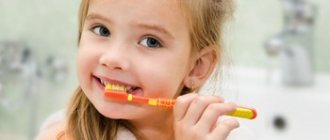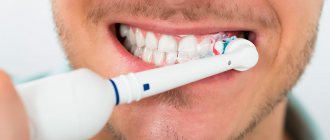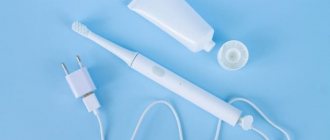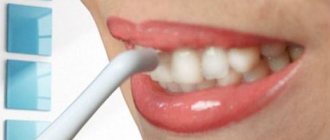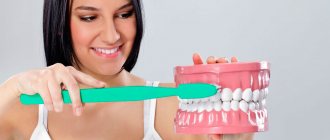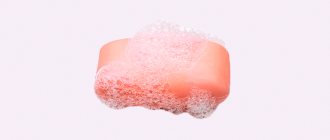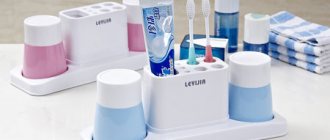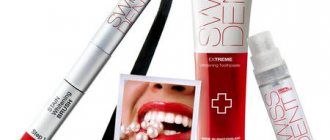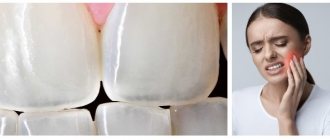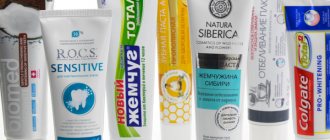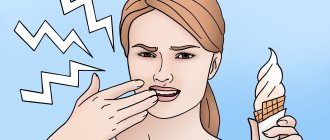From the moment of birth, you should take care of your baby's oral cavity. A toothbrush will help with this. Today, children's stores offer a fairly significant range of similar products - products can differ from each other in a number of parameters, which is why choosing the optimal model is not as easy as it might seem at first glance.
We decided to help you solve this problem and rank the best toothbrushes for children. As part of this review, we will talk in detail about the beneficial qualities of each product, analyze the advantages and disadvantages, and also give some tips on the wise choice of such products.
At what age can you start brushing your teeth?
Parents need to start taking care of their child’s oral hygiene even before the first teeth appear. Even completely bare mucous membranes are a favorable environment for the growth of bacteria. Before the age of six months, it is, of course, too early to use a brush. But in this case, you can resort to clean gauze soaked in boiled water at room temperature and wrapped around your finger. This is a suitable option to carefully treat the mucous membrane and remove plaque.
Clean gauze should be used before teething
With the appearance of the first primary incisors at 6-7 months of age, you should continue to clean soft and hard tissues using gauze. But you can now switch to a special silicone fingertip - it is also designed for gentle treatment of gums, tongue and the first strong teeth. You need to perform the procedure twice a day - just like with standard cleaning in adulthood.
The next stage usually begins at the age of 1 year. At this time, you can already move on to the first brush, but cleaning should be carried out under close parental supervision. Starting from 3 years of age, the child should be able to carry out the procedure independently.
Features of oral care during teething
The timing of the eruption of the first milk teeth is individual for each baby. Usually this process begins between 4 and 7 months, and for some, only in the first year of life. This is a delicate period that requires increased attention to the condition of the oral cavity. Experts in pediatric dentistry provide several specific recommendations in this regard:
- Excess salivary fluid must be systematically removed to prevent irritation around the mouth. To do this, you can use a clean napkin or the edge of a towel,
- It is recommended to give the baby special teethers, you can buy these at the pharmacy,
- You should not use teethers with liquid inside - there is always a risk that they will burst. You should also not refrigerate them in the freezer, as this can cause injury to your gums. It is enough for the teether to lie in the refrigerator for only 15 minutes,
- a light massage of the gums with a clean finger has worked well,
- Every time after feeding, the gums should be wiped with gauze soaked in boiled water at room temperature. Some experts allow the use of special anti-inflammatory solutions, but it is better to consult with your pediatric dentist in person on this matter.
Teethers will help ease the baby's teething process.
“My son is 1.5 years old, but the pediatrician is categorically against any brushes until he is two years old. He says there is nothing to clean there, just use a fingertip. In addition, this procedure will be too traumatic for him, and the enamel can be accidentally damaged. So I just clean my tongue with a bandage soaked in water, and my teeth separately with a fingertip.”
Ekaterina F., from correspondence on the woman.ru forum
During the period of formation of the primary occlusion, the child’s body weakens, and a slight, but still, decrease in local immunity occurs. This means that it is at this time that the baby is at greater risk of contracting an infection. The gums are already inflamed, so you should not carry out additional manipulations too often and intensively. Care should be as gentle as possible, but attentive and regular.
What is a children's electric brush?
Kids are very attracted to colorful brushes, which also buzz, which allows them to turn the cleaning process into an exciting game. But in order to make the right choice, it is worth studying in more detail the features of such products.
What types of electric brushes are there?
There are several types of such products for babies:
- Classic option.
- Sound.
- Ultrasonic.
By cleaning method
The classic one has no additional functions; the rotating head removes plaque and dirt particles. The sound models contain not only rotation, but also vibrations, which makes it possible to most effectively eliminate microbes from the surface of tooth enamel.
Oscillation waves of ultrasonic models destroy the film created by bacteria and cope with the task most effectively.
By power source
This can be a built-in battery or a removable battery. Brushes are also available that charge from an electrical outlet or from a base (like mobile phones).
Availability of several modes
Additional functions include:
- tongue cleaning mode;
- gum massage;
- sleep timer;
- built-in melodies;
- cleaning mode for the inner surface of the cheeks.
When can a child use an electric toothbrush?
Dentists do not recommend using the electric option for children under 3 years of age. Older children should choose a classic version without many additional functions as a first acquaintance with such an accessory.
First toothbrush – before and after one year
As mentioned above, each stage of growing up requires its own oral care. The following are the basic principles of maintaining hygiene in childhood:
- up to 1 year - clean the gums with gauze soaked in boiled water at room temperature, and also use silicone fingertips for more thorough cleaning of the first teeth that appear,
- after 1 year - continue to use finger pads and gradually switch to a baby brush with rubber bristles and a limiter on the handle that prevents tissue injury,
- with the appearance of incisors, canines and molars, you can begin to use a full-fledged model, but taking into account children's age, therefore with a small head and soft bristles.
You can rely on the age markings on the packaging, but most often they are too vague. Therefore, it is better to choose a model individually, according to the recommendations of the observing pediatric dentist.
Finger tip for cleaning gums and first teeth
It was already mentioned above that the first “brush” for a child should be a fingertip. Essentially, it is a small silicone cap that is designed to be placed on mom's finger. Cleaning with it is carried out according to the same principle as with a piece of gauze. This is a special device that does not injure children’s delicate gums, but provides a beneficial massage and improves blood circulation in soft tissues. Recommended age for use is 6-10 months.
With the appearance of the first teeth, you can use special silicone finger guards
It is important to consider that such a fingertip needs to be updated every 1-2 months. At the slightest sign of damage to the integrity of the brush, it must be urgently replaced with a new one. The cleaning procedure itself should take about 4-5 minutes.
How to choose a brush for a child - main characteristics
A product for the first teeth should not only be bright and attractive. It must meet a number of important criteria, and here are the main ones:
- the product must be made of high-quality plastic - be sure to check for a certificate,
- For the first years, soft or ultra-soft bristles are suitable. You can switch to medium hardness from the age of three,
- give preference to synthetic bristles, as they are more wear-resistant and do not create a favorable environment for the growth of bacteria. Natural bristles are a real breeding ground for harmful microorganisms, and regular disinfection quickly renders the product unusable. The best option during the “teeth to teeth” period is silicone bristles,
- for babies older than one year, the length of the pile should be about 11 mm, let’s say a multi-level option with a V-shaped arrangement of synthetic bristles,
- The handle must have rubberized anti-slip elements. From the age of 2-5 years, the length of the handle can reach 15 cm. It is desirable that there is a flexible connection between the base and the head,
- the head size should not exceed 15 mm - for the smallest. From the age of 2, its length can reach 20 mm, and its shape must be smooth and streamlined1,
- It is desirable that there is a rubberized ribbed surface on the back of the working area - it is designed to clean the tongue.
Be careful when choosing a children's toothbrush.
As for the appearance and design, everything depends on the preferences of the parents and the baby.
The modern assortment offers the widest variety for every taste and color.
Tips for parents
Give your baby something cold to chew on, such as a frozen tissue (rolled into a tube) or a chilled teething ring. When choosing a teether, give preference to reliable manufacturers, since the liquid filler in products of dubious quality may be unsafe for the baby.
Keep your baby's gums clean by wiping them with gauze after each feeding and massaging the gums with your finger or a soft toothbrush. If you decide to give your child an over-the-counter pain reliever, use it exactly as directed and only in the dosage indicated for the appropriate age.
Review of the best brands - for children under 3 years of age and older
Below is a rating of the best manufacturers of children's toothbrushes, based on expert recommendations and reviews from parents on the Internet. The table contains all the key information about brands that produce products for children under 3 years of age and older.
| Brand and country of origin | Characteristics and cost | Advantages and disadvantages |
| Canpol (Poland) | There are several models in stock. The Canpol babies silicone fingertip, which is ideal as a first tool for maintaining hygiene, costs about 140 rubles. There is also an option with a restrictor in the form of a ring, designed for ages from six months, costs about 200 rubles. | The fingertip has soft bristles that provide additional massage to the gums. The silicone model is characterized by increased softness of the bristles. Therefore, according to reviews, it does not always clean plaque and dirt thoroughly enough. |
| Happy Baby (UK) | Happy Baby Tooth care x3 kit with limiters, cost about 175 rubles. | Soft bristles and a protective ring, available in several models: in the form of a teether, a mucous massager and a full-fledged brush. |
| Pigeon (Japan) | Educational model for children from 10 months – 200 rubles. The range also includes a set for children from 18 months, the cost of which is about 400 rubles. | The training version, compact and convenient, designed just for a child’s hand, is equipped with a limiter. The set includes a double-sided model (from 6 to 8 months), a single-sided model (from 1 year), and a brush with a ring (from 1 to 3 years). |
| Mam (Switzerland) | The cost of a brush for mother and baby is 274 rubles. | The model is designed for ages from 6 months. Due to the special ergonomic design of the handle, the brush can be comfortably held by mother and child. Material: polypropene and silicone. |
| Oral-B (USA) | Battery operated model for ages 3 years and up. Cost – about 730 rubles. | Original design with a rubberized body, high cleaning efficiency due to circular rotation of the head, and a timer. Replacement heads are available for sale. |
| SILCA Putzi Baby (Germany) | For children over 1 year old, cost – 130 rubles. | Ergonomic rubberized handle, interesting design and soft bristles with good cleaning performance. |
Budget segment
Aquafresh My baby teeth
This product is designed for children aged three to five years, that is, they are already quite independent and are able to take care of themselves, including brushing their teeth. Available with bright caps made in the shape of animal heads. The brushes themselves are painted in eye-catching colors and different patterns, so kids will have fun caring for their teeth with these products.
More: TOP 11 + best remedies for colic in newborns
The handle here is very comfortable; it consists almost entirely of rubber inserts, so it will not slip even in wet children’s fingers. There is a suction cup on the base - the brush does not have to be put away in a cup, but can simply be stuck on the wall or on the sink. The bristles here are very soft, made of silicone, and practically do not wear off during use.
Advantages:
- The original protective cap is provided;
- Very carefully cares for children's teeth and gums;
- Attractive appearance;
- The ergonomics of the handle and suction cup are carefully thought out.
Flaws:
- The product quite quickly loses its original appearance;
- Relatively rigid connection between head and handle.
Aquafresh toothbrush My baby teeth
Colgate SpongeBob
The first electric model in our review, powered by standard batteries or traditional AA batteries. Despite its quite reasonable cost, such a brush functions very effectively. It cleans teeth thoroughly and efficiently - removing much more plaque and pathogenic bacteria than a standard toothbrush. This device is equipped with a small vibrating head. Despite the fact that it rotates quite quickly, the enamel remains intact.
The bristles are made of soft rubber, which are at a slight angle to each other. The handle of the device is of high quality, its shape is carefully thought out, so the child can easily use it independently. These products are suitable for children aged 3 years and older.
Advantages:
- Very beautiful and bright design;
- Batteries are included with the toothbrush;
- Reasonable price.
Flaws:
- There is no battery charge indicator;
- There is only one nozzle, and it is not possible to change it if necessary;
- There is no automatic shutdown timer for the device.
Colgate SpongeBob Toothbrush
Bebe comfort
The set comes with two comfortable, interesting and not quite ordinary toothbrushes from a well-known French manufacturer. One product has bristles made of silicone, the other of ordinary materials. It is worth noting that the manufacturer recommends using such products also for teething. The product handle is made of rubberized materials and has an ergonomic shape. Thanks to this solution, the brush will not slip out even from wet hands, so the likelihood of injury to the oral cavity is reduced to almost zero.
The brushes are very ordinary, they do not contain any electrical elements, so they are prepared for use in the simplest way: boiled in water for several minutes. It is worth noting that this brush can be used starting from the age of three months.
Advantages:
- The set includes two easy-to-use brushes, and each of them has a case;
- Convenient and easy to sterilize;
- Can be used for teething;
- Safe and versatile in use.
Flaws:
- The bristles are quite hard.
Bebe confort toothbrush
BABYONO
In second place in this section of our review of the best toothbrushes for children is also a set presented with three accessories at once, each of which will correspond to a certain age of the child. Such a solution from the manufacturer will be a very convenient and practical purchase, since the baby’s parents will no longer have to constantly search for and purchase toothbrushes for a new stage of dental and oral care.
The set includes a special massager suitable for the period when the child is cutting his first teeth. It will also provide complete care for the baby's gums. The silicone brush for the first teeth is made from the safest materials that will not cause an allergic reaction or irritation. The bristles themselves are very soft. The third toothbrush is designed for effective and high-quality oral care in older age. The brushes are made in a variety of colors and are characterized by a comfortable handle.
Advantages:
- The set contains the entire set of brushes that will be useful to the baby, starting literally from the moment of birth;
- The products are absolutely safe;
- Very comfortable handle.
More: TOP 10 auto tracks for children: how to choose a good children's auto track
Flaws:
- It is not found everywhere, although it is not very expensive.
BABYONO toothbrush
PresiDENT Kids-Junior
This brush is best suited for children aged 5 to 11 years; it is characterized by a very bright design and is intended exclusively for self-cleaning teeth, oral care, and so on. The handle is thick and has soft rubber inserts. On the front side you can find a slope for the thumb, on the back side there are waves for convenient placement of the remaining fingers. The head has a cone shape. The bristles are soft and graduated, made of high quality nylon, and have rounded tips.
The bristles here are divided into two bundles - upper and lower. The first one has small overall dimensions and is blue in color, the second one is larger and painted white. Both of these units are designed to thoroughly remove even the smallest food debris in the interdental spaces, effectively cleaning the back teeth. The weight of the product is only 25 grams with a length of 14.5 cm. A protective cap can also be found in the kit.
Advantages:
- Beautiful appearance that will be maintained throughout its entire service life;
- Carefully but thoroughly cares for teeth, gums and the entire oral cavity;
- Reasonable cost;
- Includes a cap for convenient storage;
- The handle will not slip in your palms.
Flaws:
- Not detected.
Toothbrush PresiDENT Kids-Junior
When can you start using electric models?
Experts in pediatric dentistry do not recommend purchasing electric toothbrushes for children under 2 years of age. In general, experts advise starting to use them no earlier than 5 years. In any case, it is impossible to use an electric model on an ongoing basis at an early age. The enamel of baby teeth is quite thin and fragile and can be easily damaged. Starting from 5-6 years old, you can begin to periodically use an electric model - the teeth should gradually get used to its effects.
An electric brush can be used from 5-6 years old
Expensive products
Xiaomi Soocas C1
This audio production is intended for children aged 4 years and older. It is equipped with a vibrating, somewhat elongated head of compact overall dimensions. The bristles here are soft, their villi are rounded, so the effect on tooth enamel and gums is very gentle. The case is made of environmentally friendly plastic, there is a built-in battery, the power of which is 2 W with a capacity of 850 mAh - it can work in autonomous mode for up to 20 days.
There are two operating modes - delicate or daily cleaning. There is a so-called habituation function; there is a sensor for pressing on the tooth. The electronics independently monitor the degree of wear of the nozzle, and there is also a timer. One of the key features of this device is its ability to synchronize with a smartphone via the Bluetooth protocol with various gadgets running on the iOS or Android platforms, for which a special SoocasKid application has been developed.
Advantages:
- Very beautiful and stylish appearance;
- The battery charge lasts a long time;
- Easy to use;
- You can take it with you on long trips if necessary.
Flaws:
- If the nozzle wears off, then finding it will be quite problematic;
- The battery takes a long time to charge.
XiaomiSoocas C1 Toothbrush
Montcarotte Kidds Toothbrush soft
The products were created for children over the age of one year, and during its development, absolutely all the features of the structure and location of teeth, as well as cleaning techniques, were taken into account. The head has an oval shape, the fibers are made of the most modern material - polyamide. The bristles are rounded at the end, quite soft and do not absorb moisture, so pathogens will not develop on their surface.
The bristles resist deformation well, so the head can last for quite a long time. At the same time, the brush does not injure the gums and is gentle on tooth enamel.
Advantages:
- The optimum ratio of price and quality;
- Safe to use;
- Gently and very effectively cleans teeth and gums;
- Suitable for gums of any sensitivity.
Flaws:
- Not detected.
Toothbrush Montcarotte Kidds Toothbrush soft
How to properly care for your first toothbrush
Modern children's models are not designed for intensive heat treatment. This means that they do not need to be doused with boiling water or boiled. They must be washed thoroughly with soap after each cleaning. It should be stored in a separate glass, with the bristles facing up. When purchasing a brush for a child, be sure to carefully read the instructions and care recommendations.
On a note! Many parents are interested in how to treat the product before first use. In fact, after unpacking the brush remains completely sterile and does not require any additional manipulations. Sometimes it is advised to pour boiling water over the bristles, but this will only help soften them a little to avoid injury to the gums.
Always consult your pediatric dentist about any hygiene products, including toothpastes. Only a doctor will be able to accurately assess the current condition of primary incisors and molars and, based on this, give correct recommendations for oral care.
1Borovsky E.V. Dental health is in our hands, 2004.
